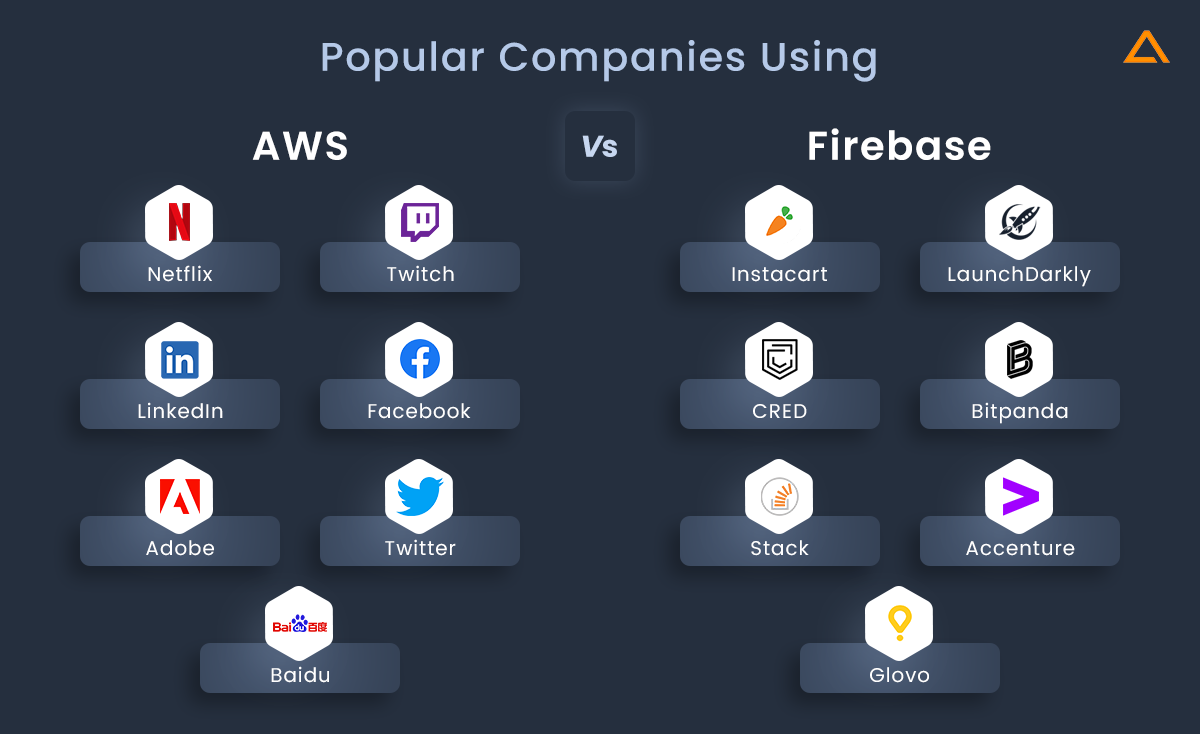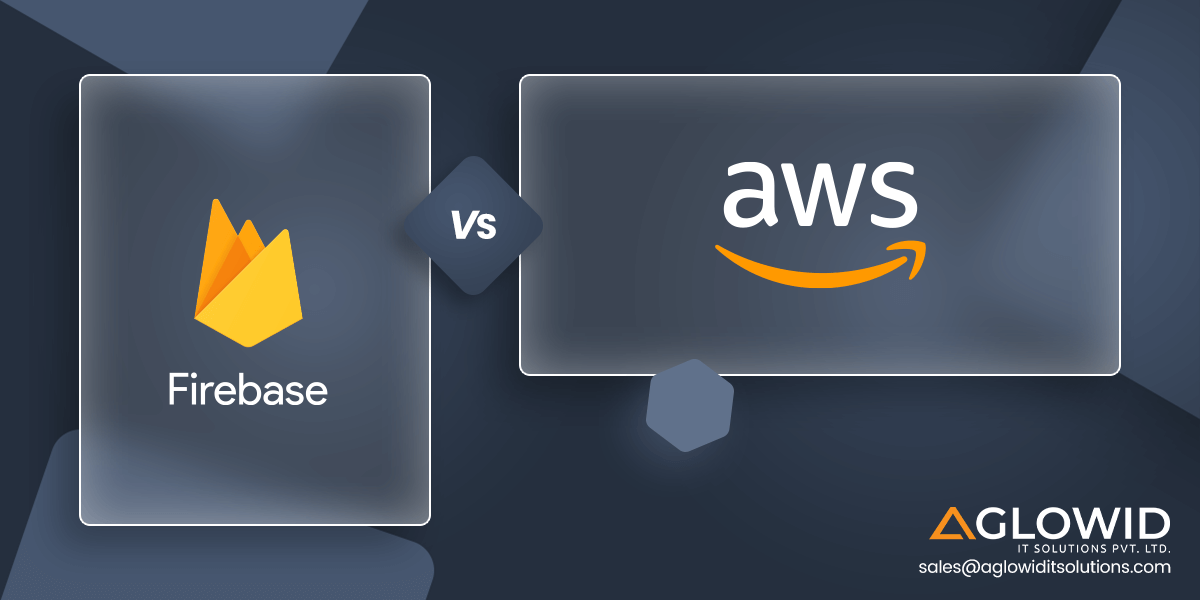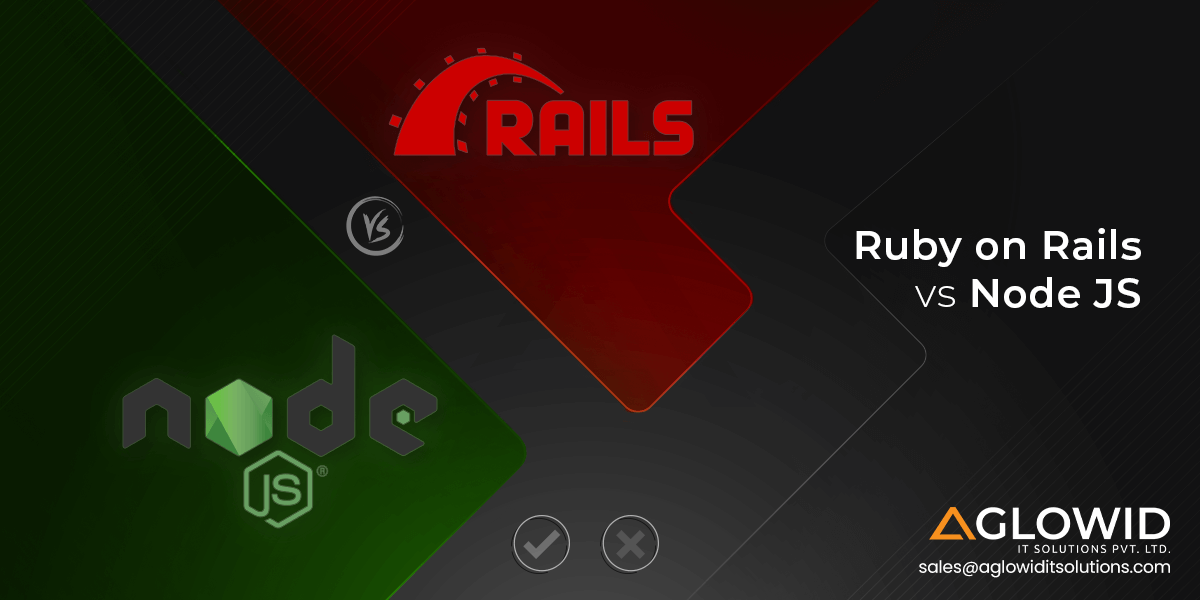Quick Summary:
How can you easily develop an efficient and robust back-end for your app? Does it appear surreal? Serverless architecture can help make this a reality. We’ll compare Firebase vs AWS, the leading serverless architecture service provider, to see how both development platforms expedite the process and make it easier for developers.
Mobile and web development have come a long way in the last few years. Modern applications have more complex features, and launching a web or mobile application needs more than just a hosting service. As part of its PaaS, various huge organizations, such as Amazon and Google, supply everything you may desire in this arena. However, as serverless architectures become more widely available, more developers and businesses opt for this strategy. When selecting the correct tech stack for your forthcoming project, paying attention to each requirement is critical.
Both Firebase and AWS provide access to a unique set of tools that aid in creating and delivering viable apps. These tools aid in developing web and mobile applications, and the administration of processes improves user engagement and rapid deployment. Because Firebase and AWS offer a secure backend, developers can concentrate more on the front end and improve the user experience.
The popularity of both AWS and Firebase can be seen through the following statistics:
- According to BuiltWith, there are 891,819 websites are using Firebase from which 254,372 websites are live. Along with additional 210,486 domains that redirect to sites in this list.
- According to BuiltWith, 21,206,026 live websites are using Amazon.
- According to Statista, Amazon leads with a revenue of $150 billion cloud market showing the growth of 47% in the income.
- Whereas Google Cloud reported revenue of $4.047 billion, an increase of 46% year-over-year.
Note that we know about the popularity of both let’s get the overview about each of them and their differences.
Firebase vs AWS: Overview
The following is the overview for Firebase and AWS.
Firebase
Google’s BaaS (Backend as a Service) is Firebase. These services and tools will save you time by allowing you to construct high-quality mobile and web applications without having to start from scratch every time.
Firebase is a handy cloud computing service paradigm for connecting App developers‘ applications to APIs and back-end cloud storage abstracted by back-end applications. The fact that Firebase is built on Google infrastructure is crucial.
The goal of Google Firebase is to assist the mobile and web developer teams in their endeavours. They put a lot of emphasis on app development teams. Their services are built around three areas:
- Building better apps
- Improving app quality
- Growing Business.
Google acquired Firebase in 2014 after it was created in 2011. The platform’s usage has grown by 1.5 million apps since Google purchased it.
AWS
Amazon Web Services, or AWS, is the world’s most widely used and comprehensive cloud platform. It has over 175 features services available from its data centre worldwide. Because cloud computing encompasses many services, such as IaaS and PaaS, the phrase is used here.
AWS provides cloud computing solutions that are highly adaptable, scalable, dependable, and customizable, and Amazon provides a comprehensive and economical cloud platform.
For the first quarter of 2021, AWS retains a market share of 32%, as indicated in the graph.
Firebase vs AWS: Common Service Provided
Core features that are common in both Firebase and AWS are as follows:

- Auth
- Push notifications
- Storage
- Hosting
- Analytics
- Security
These all are offered to easily deploy your serverless solutions using any of these serverless platforms.
AWS vs Firebase: Benefits
Let’s look at the benefits of AWS vs Firebase enlisted below to get a better idea about things in this regard.
| AWS | Firebase |
| Less Expensive | Managed Services |
| Self-Hosting | Google Analytics has made Firebase smarter |
| Reliable APIs | Real-time database |
| More functionalities | Crash Reporting for quick bug fix |
| Higher Secure services | Faster |
| Pay as you go, service model | Secure |

AWS vs Firebase: Features
The following are the AWS and Firebase Features available.
| AWS | Firebase |
| Extend other AWS services with custom logic. | Incredible Built-In analytics |
| Build custom backend services | Cloud messaging |
| Bring your code | Authentication |
| Complete automated administration | Audience Segmentation |
| Built-in fault tolerance | Integration with 3rd party services |
| Package & deploy functions as a container image | Growth & User engagement |
| Automatic Scaling | Crash-Reporting |
| Connect to relational database | Real-time database |
| Fine-grained control over performance | Adwords |
| Connect to the shared file system | App Indexing |
| Run code in response to Amazon CloudFront Request. | Remote configuration |
Firebase vs AWS: Pros and Cons
The following are the Pros & Cons of Firebase and AWS.
Firebase
| Pros | Cons |
| Database Capabilities | Limited querying capabilities |
| A wide range of services and features | Limited data migrations |
| Free basic plan | Platform dependence |
| Concise documentation | Android centred |
| Quick and easy integration & setup | Less support for iOS |
AWS
| Pros | Cons |
| Reduced cost of Execution | No Control over enviorment |
| Improved Application Flexibility | Complex call patterns |
| Saves Time & Effort | Cold Start |
| Helps build a scalable solution | Computational rest |
| Pay for what you need | Issues working with Virtual Private Cloud |
AWS vs Firebase: Services Provided
The following are the services offered by AWS & firebase.
Firebase
Services provided by Firebase are as follows:
- Cloud Firestore
- ML Kit
- Cloud Functions
- Authentication
- Hosting
- Cloud Storage
- Realtime database
- Crashlytics
- Performance Monitoring
- Google Analytics
- Cloud Messaging
- Remote Config
AWS
Services provided by AWS are as follows:
- EC2
- Elastic Beanstalk
- Lambda
- VPC
- EC2 Containing Service
- Glacier
- Elastic Load balancing
- Data Pipeline
- Machine Learning
- Snowball
- DynamoDB
- Redshift
- Data Migration Services


Firebase vs AWS: Tabular Comparision
| Factors | AWS | Firebase |
| Parent company | Amazon | |
| Launch Date | 2006 | 2011 |
| Category | IaaS | BaaS |
| Employees | 10000+ | 200-500 |
| Core Features | Virtual Machine Block Storage Load Balance |
Realtime database Scalable Hosting Analytics |
| Server-Level Access | Yes | No |
| Pricing | Cheaper | More expensive |
| Pricing model | Free Tier Pay as you go |
Free Tier Pay as you go |
| Ideal For | Large & Sophisticated Projects | Reduced time to market & have an end-to-end development experience |
| API | REST and GraphQL | REST |
| Function Creation | More upfront configuration | Fewer configuration required |
| Deployment | Approx deployment time is 40 seconds | Approx deployment time is 40 seconds |
| Testing | Have built-in functions | Don’t have a built-in function |
| Hosting | $0,01/build minute $0,15/GB served |
$0,026/GB stored/month $0,15/GB served |
| Auth | From $5,50/1000 users | Free |
| Database | $4.00/mill Operations $2.00/mill Real-time Updates $0.08/mill minutes of connection $0.09/GB Data Transfer Caching from $0.044 |
Firestore – $0,18/GiB stored Firestore writes- $0,18/100k Firestore reads- $0,06/100k Firestore deletes- $0,02/100k Firestore egress from $0,01/GiB Realtime – $5/GB stored Realtime – $1/GB downloaded |
| Push Notification | from $0,50/mill | Free |
| File Storage | from $0.023/GB | $0.026/GB stored $0.12/GB downloaded $0.05/10k upload operations $0.004/10k download operations |
Make your Mobile App Market-Ready with Greater Performance?
Connect with Certified Experts
AWS vs Firebase: Key comparison points
Following are some of the key comparison between AWS and Firebase.
1. The User authentication
For most apps, authentication is a must. Users must be authenticated, and only authorized users should have access to data and functionality.
Firebase Authentication
There are a variety of login authentication mechanisms available in Firebase. Like traditional username and password authentication to third-party authentication from Google, Facebook, Apple, Twitter, Microsoft, and GitHub. It also can authenticate via SMS or email, confirming the user’s contact information. You can even allow your users to log in using any of the choices above, and their firebase account will be linked to them.
Firebase Authentication Pricing
- Up to 10K SMS Au thentication per month –> Free
- All other authentications –> Free
AWS Cognito
You may utilize the AWS Cognito service to access social networking networks including Facebook, Google, Amazon, and Apple. Cognito may also issue verification codes to authenticate phone numbers and email addresses. Users are successfully authenticated once they receive the verification code.
AWS Cognito Pricing
- Up to 50k monthly active users -> FREE.
- 50,001-100,000 -> $0.0055 per Monthly Active User.
When evaluating authentication services, simplicity and cost are important considerations. In a nutshell, Firebase authentication is simple to use.
2. Database services
Most apps will require a database service to store and retrieve data in the cloud. Your program may need to synchronize data between multiple users and devices.
Firebase Database Services
Cloud Firestone and Firebase Realtime Database are two database services offered by Firebase. On the other hand, NoSQL databases are applications that are specific to each database. The SDK is used to communicate with the database in both database services. This eliminates the need to engage with application server tiers and makes getting your app up and running a breeze. Both enable multi-device syncing.
Firebase Realtime Pricing ( Free-Tier)
- Up to 100 simultaneous connections
- 1 GB Storage
- 10 GB Download
Firestore Pricing (FREE Tier)
- 1 Gib Storage
- 10 GiB/month Network Egress
- 20k/day Document Write
- 50k/day Document Reads
- 20k/day Document Deletes
AWS Database Services
AWS offers a wide range of database services from the NoSQL Amazon DynamoDB to the relational Amazon Aurora Serverless database. Both of these database servers are self-managing and automatically scaling on-demand services. AWS also provides instance-based database services, which can host a range of database formats.
If you want to use a relational database in your project, AWS is the way to go. With the help of AWS AppSync, you can automatically synchronize data between your local device and remote storage.
Dynamo DB Pricing (FREE Tier)
- 25 GB of data storage
- 5 million read requests per month
- 1 GB of data transfer out
Whatever database you need, AWS provides a solution for you. AWS can satisfy your needs by providing several database types in a self-managed or managed instance. Amazon DynamoDB’s free tier pricing is more attractive than Firestone’s.
3. Server Less Function
Regardless of the project type, server-side functionality is required. This could be complex business logic or simple post-processing of user-generated content such as photographs and videos.
Before serverless functionality, we had server-side logic located on either cloud-based servers like Amazon EC2 or physical hardware. It took a lot of time and effort to manage this infrastructure, which took time away from giving value to your customers.
Now we can turn our code into serverless functions that manage themselves. They can scale autonomously to meet load requirements. This frees us up to focus on functionality rather than infrastructure upkeep.
Firebase Cloud Functions
Firebase supports server-side code via ‘Cloud functions,’ self-managed serverless functions. The Node.js version 10 environment can only be written in JavaScript or TypeScript.
You can use the command-line interface to Push your functions after they’ve been developed and tested. Firestore triggers from various Firebase services, such as Firestone, can be used to call cloud functions. This is a valuable feature if you wish to use cloud functions in response to specific events.
They can also be triggered by executing an HTTP endpoint published by the cloud foundation from your client app using the Firebase SDK.
Firebase Cloud Function Pricing
- 2 million invocations per month
- 400K of GB seconds and 200k GHz per month of compute time.
- 5GB outbound Internet traffic per month.
Note: Even for the free tier, you need to have an active billing account, and the usage beyond the free tier will automatically be charged with an active billing account.
AWS Lambda Function
In AWS, serverless functions are called ‘AWS lambda functions.’ They let you design server-side functionality without having to worry about infrastructure management. They can also autoscale to fit your load needs. Support for various programming languages is one of the most important requirements for Google Cloud functionalities. Java, Go, Powershell, Node.js, C#, Python, and Ruby are supported via Lambda functions.
Other AWS Cloud Services, such as a trigger from DynoamoDB or AWS S3 file storage, can also be used to trigger your routines. Data can now be transferred as it moves through the AWS infrastructure.
The Amazon API gateway must be installed to call the lambda function. Your gateway then invokes the Lambda functions.
Amazon API Pricing
- 1 million API calls within first 12 months -> FREE
- After 12 months or if you exceed the one million API calls within the first 12 months -> $1.29 per million calls up to 300 million calls
Lambda Functions Pricing
1 million requests and 400k GB seconds of computing time per month -> FREE
4. Cloud Storage
The majority of apps necessitate the use of cloud storage. This could be in the form of user-generated content, such as movies and images, that has to be saved. Keep in mind, though, that this isn’t the same as a database service.
Firebase Cloud Storage
Following are the features provided by Firebase Cloud:
- Uploads and downloads are resilient in the face of fluctuating connections thanks to robust processes
- Only authorized users can access the file thanks to the integration with Firebase Authentication.
- Spotify and Google Photos leverage infrastructure that gives extra byte scalability.
Cloud Storage Pricing
FREE Tier:
- 5 GB storage
- 1 GB downloads per day
- 20k upload operations per day
- 50k download operations per day
Over FREE Tier:
- Storage: $0.026/GB per month
- Downloads: $0.12/GB
- Upload operations: $0.05 for 10k operations
- Download operations: $0.004 for 10k operations
AWS S3 Storage
S3, an AWS enterprise standard solution, is available. Files are kept in ‘buckets,’ which are non-hierarchical structures. Each file can have up to 10 key-value pairs appended to it. These values can be kept throughout the project that has been saved. Inventory reports can be used to keep track of the data stored in S3.
In S3, the versioning option enables object rollback in the event of unintentional deletion or alteration. Multifactor authentication delete can also help to prevent accidental deletion. When you try to delete, you will be asked to provide several means of authentication.
There is replication in both the same and separate AWS zones. This reduces latency and improves data recovery in the event of a disaster. AWS also offers extensive S3 monitoring and control, allowing you to keep track of not only the resources being used but also the invoicing for your AWS account.
It also enables control of costs by having different storage classes. It also has excellent security and management features with the help of AWS Identity & Acess Management.
AWS S3 Pricing
Storage costs for first 50 TB / Month: $0.025 per GB
AWS vs Firebase: Use Cases (when to use and when not to use)
When to use AWS Lambda?
- To handle complex instructions
- You need security and stability
- You need services with custom logic
- Create your backend services
- Services that operate at AWS scale

When not to use AWS Lambda
- It is not appropriate to use AWS Lambda software packages or applications which rely on calling underlying windows RPCs.
- It is used for custom software applications with licensing agreements like MS Office document processing, oracle database, etc.
- It should not be used for custom hardware processes.

When to use Firebase
- To share data
- To handle less than 1 million connections
- To build simple apps
- To implement real-time features
- To deliver faster
- To integrate with helpful tools

When not to use Firebase
- To handle complex queries
- Never share data with third-party tools
- To integrate with microservices
- To perform BI functionalities
- To skip idea validation
- To ensure high data integrity

AWS vs Firebase: Popular company using them
Following are some of the big names that are using AWS and Firebase
AWS
- Netflix
- Twitch
- Adobe
- Baidu
Firebase
- Instacart
- LaunchDarkly
- CRED
- Bitpanda
- Stack
- Accenture
- Glovo

Firebase vs AWS: Final Thoughts.
In a nutshell, we can say that
Firebase
- Easy to set up and maintain.
- Simple and cheaper
- Requires you to make fewer decisions, a great fit for simpler applications
AWS
- More Flexible
- Useful for enterprise-level and complex application
- It might not be the right choice for a small application
- You can develop a neatly packaged solution for all of your application needs, but it will cost a little extra.
have a unique app Idea?
Hire Certified Developers To Build Robust Feature, Rich App And Websites
Aside from these features, technical aspects such as market demand, popularity, delivery speed, development costs, and, most importantly, your project requirements must be considered.





 Say
Say